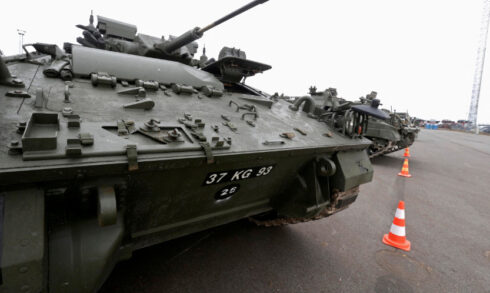Written by Ahmed Adel, Cairo-based geopolitics and political economy researcher
According to the AP news agency, citing the Stockholm Peace Research Institute (SIPRI), Western arms companies could not cope with the volume of orders and, furthermore, could not adapt production to “high-intensity warfare.” This has exposed Western countries, most notably the US and the UK, as they do not have the strong defence industries that they would have people believe in.
“Many arms companies faced obstacles in adjusting to production for high-intensity warfare,” said Lucie Béraud-Sudreau, director of the independent institute’s Military Expenditure and Arms Production Program.
Nan Tian, a senior researcher with SIPRI, said, “We are beginning to see an influx of new orders linked to the war in Ukraine.” He cited some major US companies, including Lockheed Martin and Raytheon Technologies, and said that because of “existing order backlogs and difficulties in ramping up production capacity, the revenue from these orders will probably only be reflected in company accounts in two to three years’ time.”
In 2022, the largest companies in the global military industry showed a drop in revenues of 3.5%, and the main American companies were even 7.9% less than in 2021. The increase in orders generated by the conflict in Ukraine is expected to weigh on revenue growth in the coming years, but in the meantime, Asian industries are benefiting from the situation.
SIPRI’s revelation comes as an exposed draft Pentagon report found that the US defence industrial base lacks the capacity and speed needed to meet military demand fully. The National Defense Industrial Strategy, cited by Politico on December 2, said that the US is unable to build its weapons quickly enough, and the mismatch between quality and speed presents a “growing strategic risk” as Washington needs to support active combat operations, “while deterring the larger and more technically advanced pacing threat looming in the Indo-Pacific” – China.
The US is not the only Western country facing defence industry issues either. The United Kingdom’s Armed Forces face an equipment funding deficit of £17 billion over the next ten years, the National Audit Office (NAO) said on December 4. According to Reuters, NAO raised the budget estimate for new weapons and equipment at £305.5 billion for 2023–2033, £16.9 billion above budget, the largest deficit since its first report in 2012.
The cabinet said that rising costs in nuclear and naval programs — as the UK works on a replacement nuclear deterrent — and high inflation have increased the future budget.
UK Defence Secretary Grant Shapps said in response to the watchdog’s report that although the government anticipated some budgetary pressure, “the department is confident it can live within its equipment budget.”
The British government increased defence spending by a further £5 billion earlier this year, taking it from 2% to around 2.25% of GDP in 2023 and 2024. Shapps said the NAO report did not consider the government’s aspiration to increase defence spending to 2.5% of GDP, which would occur when economic conditions permitted.
But, according to NAO chief Gareth Davies, “the Ministry of Defence acknowledges that its Equipment Plan for 2023–2033 is unaffordable” and that decisions over scrapping or scaling back projects likely to be deemed “unaffordable” should not be deferred as this would risk “poor value for money.”
The US’ and UK’s mad drive to fund and arms Ukraine to the maximum of their capabilities has left them weaker, and with no gain against the Russian armed forces to show for it.
According to Pentagon statistics, Washington has sent Ukraine about $44 billion in military aid since February 2022 and $76 billion in other support, including budget funding and humanitarian aid. Although US President Joe Biden has called for billions more to be approved, the Republican majority in the House, now led by Republican Mike Johnson, has remained firm in its position of not sending funds to Kiev until there is some supervision over their spending.
Although the US and UK have been left exposed to industry weakness, especially if they want to confront China in the Pacific Ocean, they are not directly fighting a losing war like Ukraine, whose leadership stubbornly refuses to end the fighting despite the impossibility of winning and receiving substantial and sustained support from the West.
Ukrainian President Volodymyr Zelensky is frustrated that his country has been relegated to the background, competing with Israel for the attention, supplies, and financing of the United States and the European Union, among other factors. With the US struggling to meet the demands of “high-intensity warfare,” there is no chance that Ukraine will be able to reverse the predicament of eventual capitulation. At the same time, though, the US has weakened its capabilities to meet the Chinese challenge.





i don’t know if this surprise is because the people who are discussing are too young? but the usa ran out of bombs when bombing iraq so completely that conventional explosives were loaded into the shells of the nuclear bombs. that’s why the 1991 war ended in reality. the same happened when yugoslavia was bombed. the western powers don’t really have the reserves to fight years of war, nor the capacity to produce munitions in the way they threaten.